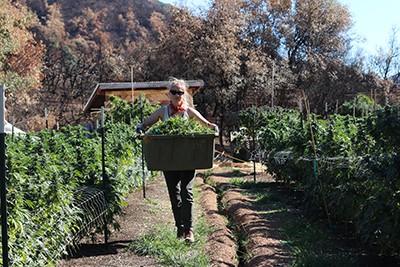Navigating California Cannabis Market Correction: Q&A With Aster Farms CEO Julia Jacobson
Marijuana Industry News February 7, 2022 MJ Shareholders
Julia Jacobson, CEO of Aster Farms, founder her California-based cannabis cultivation in 2017, with the first harvest occurring in 2018. In the years since launching Aster Farms, Jacobson has seen the ups and downs of the California market, as well as the industry’s continued growth not just in The Golden State, but across the U.S.
As 2022 unfolds, Jacobson offers her perspective on the current state of the market in California and the industry as a whole, while also explaining the importance of honoring legacy operators, sustainable farming practices, and more.
Zach Mentz: How did you end up in the cannabis industry? And is this something that you ever thought you’d be doing as a career?

© Aster Farms
Julia Jacobson: I never in a million years thought that I would be running a cannabis company one day. Never. Even though I have been a consumer for decades, I didn’t think that I would be here.
My personal path began with my chronic migraines, which started in my mid-twenties and became completely debilitating. I was having trouble showing up for everything in my life and was ending up in the hospital on a regular basis. I had tried everything from every kind of prescription medication, acupuncture, chiropractic work, shots of lidocaine in my forehead–you name it. And I was really kind of desperate. And one of the times I was in the hospital, the ER doctor said, if you have access to cannabis and you feel comfortable with it, for people who prescription medication hasn’t worked for migraines, I recommend you use cannabis.
Even though I had been a daily consumer for years, when I have a migraine, the last thing I think to do is to light up a joint. I tried, and it completely changed my life. So, for me, that was the moment when cannabis went from something that was just a fun part of my life to an important piece of my ability to show up and live my life. It became incredibly important and it helped me look at the plant and the industry and cannabis in a completely different way.
Simultaneously, my husband’s story goes back a few decades longer. His family has been growing cannabis in Mendocino County since the early ‘70s. He is from three generations of cannabis cultivators. It was a family operation, and his grandfather was actually the first person in all of Mendocino to go to prison for growing weed.
RELATED: Beyond the Show: Julia Jacobson
ZM: What were your initial challenges of launching a cultivation operation, especially in a market as competitive as California?
JJ: At those beginning days, it was honestly about constantly reading and rereading and then having 10 more people reread the regulations to make sure you were putting every foot in front of you the way it needed to be.
When it came to packaging, we specifically made sure all of our packaging was covering every basis for all of the requirements that were starting to unfold because we knew when the regulations switched on July 1, 2018, there was going to be a dearth of product available that actually satisfied compliance. We wanted to be there to be able to fill that, and it was a great strategy for us.
But all of those little details cost money and take time. And so, I think that was one of the most challenging things, just constantly watching the regulations change and down to the very specific levels of like the font on this particular thing that you have to put in this place on here that needs to be this size. So that was quite the roller coaster. It was also exciting.
We had no idea what the actual packaging capacity was going to be for producing at a commercial scale like this. In the legacy days, Sam’s family didn’t put it in jars with tamper seals with the final test label on it at exactly 3.54 grams with a 0.03 variance. So that was a surprise. We could not package fast enough with our small team doing it by hand to keep up with our orders. So, our distributor, NABIS, sent like five people from their team, and they were a tiny team at that time, too. So it was like half their company, they sent up to Aster Farms to help us package for a day to try to get more product into the warehouse.
That was wonderful. We, we love them.
RELATED: Beyond the Show: Jun S. Lee
ZM: One of the industry’s current growing pains is how it meshes legacy operators with the new school money and multistate operators that come into the industry. Is that something that’s been a challenge from your perspective? Is it something you expect to evolve a lot in the coming years?
JJ: It’s absolutely a challenge. It’s a challenge on multiple levels. It’s a challenge in terms of a barrier to entry.
First of all, it is a lot of upfront money to just apply for a license, to be able to hire all of the various agencies who have to sign off on things like environmental protection, a cultural bio assessment and all of that. It’s really expensive. So that’s a barrier to entry in terms of the bureaucracy and the constant paper trails that you have to follow, and it’s really a full-time job. You can’t have another job. So, there are a lot of barriers to entry.
So, I think on the legacy side, that is a challenge in the way that some of the regulations were laid out in California. For example, in Mendocino, it was specifically designed to support small farmers by limiting the canopy size that any operator can have; that was intended to avoid big ag. But that doesn’t work when Salinas and Carpinteria and Santa Barbara and, frankly, Lake County, where we are, and Humboldt [County] allow practically unlimited canopy licenses. And the market is completely flooded and oversaturated with not great quality cannabis, but still oversaturated with flower. So, a regulation that was designed to support these small legacy farmers has actually crippled them because the financial economics of operating a 10,000-square-foot grow do not work in the current prices of our market today.
What we’re hearing is a significant number of those small legacy farmers, this is their last season. It’s over. These are the people who created this industry. We owe it to them to support them and keep that piece of the industry alive. We are losing grow practices from these people being out of the market. We are losing communities’ revenue sources if the [illicit] market is really being cramped down on and people are also shut out of the legal market. There are certain counties that rely on cannabis revenue for their community to survive.
Another thing people aren’t talking about is that heritage genetics are going to be lost. If you look at the nurseries that are providing at scale to some of these large operators who are growing in vast greenhouses that used to be carnation factories, they’re growing Blue Dream, they’re growing Cookies and Dessert strains. They’re growing whatever the fad is today that has absolutely no resemblance to the landrace strains that came from California. These strains, like the Cookies strains, were developed indoors. We are losing these small legacy farmers within this next 12 months; it’s happening right now. That existential moment is today. We are losing landrace genetics, and nobody’s talking about that. What makes California special is our seeds, and we’re about to lose our seeds. It’s horrible. It’s horrible.
That’s what I predict for 2022–a small contraction in flower supply in the California market. I think prices will raise slightly. But I think the market correction that has happened is a market correction that was coming, and this is approximately where we’re going to stand. A lot of these legacy operators will be completely shut out.
ZM: Do you view the current price compression in California right now as an over correction? Or do you think this is where it was meant to ultimately end up?
JJ: No, it is an overcorrection. The pendulum swings really hard in cannabis in both directions, and it swings really fast too.
For example, prices for an outdoor pound at wholesale back in pre-June were about $1,000 a pound; same harvest, two months later, $300 a pound. And that’s not because of age and freshness, that’s because of the market being flooded and oversaturated.
There’s no other industry that has multiples on their costs that go into producing a product the way that cannabis did. So, the market correction is correct. I think it swung a little bit too hard, but that’s how it’s always happening in cannabis in every aspect of this industry.
So, for example, if outdoor pounds are $300 right now, I think the proper place they will settle in the market is about $500, but $300 is a lot closer to $500 than $1,000-plus.
ZM: Are there regulations that you would like to see implemented that aren’t being implemented anywhere yet?

© Aster Farms
JJ: I think there needed to be more coordination and consensus and rules around how all of the counties went into this. For example, you have counties like Marin or Napa that have completely said no to cultivation. And there are other counties where it’s not necessarily the ideal place to grow, and it’s kicking out traditional crops. It’s just causing a lot of dynamics. So, I think it would’ve been better if policies were required to be a little bit more uniform or within some boundaries that kept the playing field even between regions.
I think that would have supported the Emerald Triangle more because you also have to remember legacy farmers are not in–I don’t want to speak for everybody–are not necessarily in a position to sell their property in Mendocino [County] and go find another one in a county that does have favorable regulations. Whereas, these corporate cannabis companies can literally choose where they want to operate based on the regulations, so there’s a lot of unfair dynamics there. California meant to do [well], the intention was good. The execution, I think, was not fully thought through in how the dynamics were going to play.
There’s also a lot of lobbying going on by the companies that have the big Salinas and Carpinteria and whatnot operations. So that’s also a dynamic. In allowing unlimited licensing in areas like Carpenteria, Santa Barbara, where there’s infrastructure for these large carnation greenhouses [and] large green facilities that require multimillions of dollars to actually acquire and flip into cannabis are only in reach for corporate companies. Yes, people are lobbying in Mendocino [County], [but] they do not have the same money lobbying in Mendocino [County] that they have in some of these other areas where they know that they can just pump money into a flipped operation.
ZM: What are some of the differences between growing in your backyard or your closet and then trying to do this at scale for an entire business? What are some of those challenges in that transition?
JJ: An interesting thing about the transition from the legacy market to the commercial legal market is that all of the best growers, some of whom we employ, have never grown 4,000 plants or 40,000 auto plants, which is a new trend in terms of plant varieties species. So, it’s really the amount of care and attention that it takes for a single plant in terms of bottom leafing, bottom cleaning, making sure you don’t have various pest problems, etc. Pest problems involve small scopes, [and] the moment you see actual damage from pests, you are past the point of it being easy to solve. So actual pest control means looking for these really minute, small signs. Sometimes it means looking for a very small bug early on, which is difficult and takes a lot of time.
We grow in living soil, and we try to keep as consistent across both fields as possible, but the nutrients take differently, so making sure you are properly managing the nutrients in an acre versus a couple pots in your back backyard is very time-consuming and involves a lot of human labor and attention. It’s hard to realize how much incremental effort actually goes into growing at scale compared to growing a few plants in your backyard.
ZM: Can you talk a little bit more about auto plants and how those are beneficial?
JJ: So, auto-flower, all also known as day-neutral, is the third type of cannabis. So, sativa, indica and ruderalis is [the cannabis plant’s] scientific name. Ruderalis originates from Siberia and was developed naturally through evolution to not be as photo-sensitive and also be able to endure harsher conditions in terms of soil and nutrients, rain, wind, all of that. So, it’s a plant that instead of being triggered by light, it automatically starts flowering as it’s vegging at the same time. They only grow to be about two to three feet high, so it’s a much smaller yield, but the plant finishes its entire cycle from seed to harvest in about 80 days. It can be grown in shallower soil does, [and it does] not need the same attention to detail in terms of its nutrients, so it’s just a much heartier plant. It doesn’t come out with the same dense bud structure as a regular full-term [cannabis plant] per se, but it still has great terpene profiles. While the potency doesn’t necessarily test above 18% or 20%, it still extracts really well because of the ratio to the plant stock matter and whatnot. We love auto-flowers. We use them for fresh frozen to do our collaboration products, for any infused products that we’re doing with other brands, and we also choose the best of the auto-flower buds to sell in our regular line because it’s really just another kind of cannabis. They’re great. They’re fantastic.
ZM: Is auto-flower something you expect see continue to emerge in the market?
JJ: I think it will depend on a couple things. One, regional geography. There are going to be certain states that are coming online that probably are less ideal for growing full terms, and that’s where autos might have a better opportunity–colder climates, rainier climates, where the growth season is a little bit shorter, more unpredictable and has harsher weather.
I also see pricing in the distillate and extraction market being a factor in this. The prices in extraction have completely crashed in California, so there does come a point where it actually doesn’t make economic sense to extract an auto-flower. There have been great auto-genetics in the market, and there have been pretty bad auto-genetics in the market. The tricky thing in California is there are so few licensed nurseries that we’re all kind of handcuffed to those who produce the seeds and the clones. So, we will see how the genetics continue to develop or get really diluted.
ZM: In regard to cannabis cultivation, what do the terms sustainability and organic practices mean to you, and why are they so important?
JJ: To me, sustainability is more than just agricultural practices. It means inclusive hiring, it means creating careers instead of jobs, it means being connected to your community and caring. For us, sustainability is really a 360[-degree], all-around approach. When it comes to our agricultural practices and our packaging on our agricultural practices, we do regenerative agriculture. That means we do no-till soil, living soil that we have been building one patch over approximately 10 years now and the other one has been building over approximately four years now.
We use cover crops in the offseason to naturally replenish nutrients, to aerate the soil, and to bring compost back in when we disc it back into their earth. We use mulch drip lines with very, very careful irrigation and water use. Water efficiency is incredibly important, especially as we’re in a drought in California.
And then [we’re] continually looking at our practices and finding ways to improve. We do pull electricity, we have a processing facility where we dry and process and package our weed. We are not at a place where we can turn that completely to solar right now. So, we are not perfect, but what we can do is be transparent and start the conversation and be continually looking at our own practices and find the ways that we can make change today and set the path to make bigger changes in the future.
Editor’s Note: This article has been edited for length and clarity.
MJ Shareholders
MJShareholders.com is the largest dedicated financial network and leading corporate communications firm serving the legal cannabis industry. Our network aims to connect public marijuana companies with these focused cannabis audiences across the US and Canada that are critical for growth: Short and long term cannabis investors Active funding sources Mainstream media Business leaders Cannabis consumers










